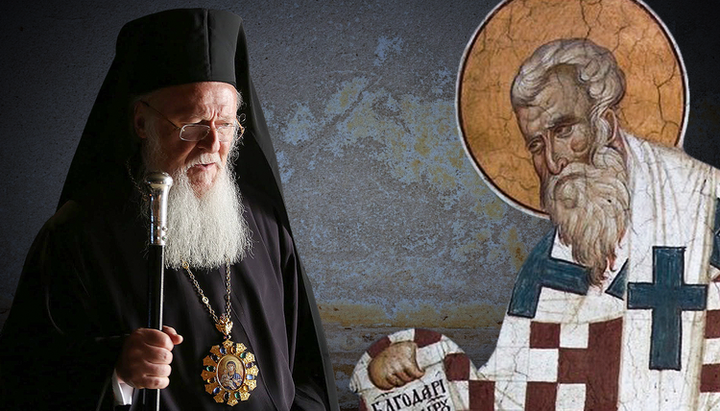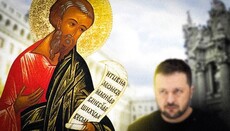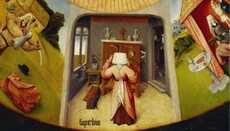Saint Ignatius and Patriarch Bartholomew – two images of hierarchs

On February 11, the Church celebrates the memory of the martyr Ignatius the God-bearer (Antioch).
The nickname "God-bearer" is associated with several episodes from the life of St. Ignatius. According to the Antioch martyrology, the bishop, when asked by Emperor Trajan: “And who is a God-bearing?” answered: “He who bears Christ in his chest”. There is also a western medieval legend that in the heart of St. Ignatius, torn by beasts, believers saw the name of Jesus Christ written in golden letters. According to another version, Saint Ignatius is called the God-bearer because God carried him in his arms – they assume that he was the child whom Christ pointed out to his disciples (Matt. 18, 2-5) and, possibly, took him in his arms.
Saint Ignatius was the second Bishop of Antioch. He occupied the throne from about 68 to 107 years.
Once emperor Traian, during the campaign against the Armenians and Parthians in 107, passed through Antioch. Here he learned that Bishop Ignatius openly confesses Christ and generally has great authority in Antioch. The threat of serious persecution was looming over the Antiochian Church. Then Saint Ignatius voluntarily appeared before the emperor in order to avert the persecution through his sacrifice. The emperor, having made a number of attempts to persuade the bishop to accept paganism, decided to send him to Rome to be devoured by beasts.
Saint Ignatius gladly accepted the sentence and went to Rome in custody. He was guarded by 10 Roman soldiers, whom he called “leopards” for their cruelty. The path ran from Antioch on the sea, then through the western part of Minor Asia. “Passing through Asia under the supervision of the strictest guards, he strengthened the believers in cities at stops with admonitions and persuasion, telling them, first of all, to hedge against heresies that had just appeared in the light of God and urged them to stick to the Apostolic Tradition, which he, facing death, considered it necessary to fix in writing,” wrote the historian Eusebius (4th century) about this period of the life of St. Ignatius.
In Smyrna, convicted Ignatius met Bishop Polycarp with Christians. The churches of Ephesus, Trall, and Magnesia sent their representatives to Smyrna to bid farewell to the bishop going to meet his death. Saint Ignatius handed them letters to their communities.
In one of the epistles, he wrote startling words: “I write to the churches and tell everyone that I am voluntarily dying for God unless you hinder me. I implore you: do not lend me untimely love. Leave me to be the food of the beasts, and through them reach God. I am the wheat of God: let the teeth of animals grind me up so that I might become the pure bread of Christ” (Epistle to Romans 4).
Saint Ignatius wrote this because the Christians of Asia Minor and Rome in every way wanted to help him avoid execution.
“I write to you alive, eager to die. My love was crucified, and there is no fire in me that loves substance, but the water that lives in me speaks to me from the inside: “Go to the Father.” For me there is no sweetness in the perishable food nor in the pleasures of this life” (Epistle Romans 7), he wrote in the same letter.
Soon the saint arrived in Rome. For the sake of amusement of satiate Roman patricians and people, the old bishop was thrown to the lions in the Colosseum. After the execution, the believers collected the remains of the martyr and buried them in the suburbs of Antioch in the cemetery. In 438, the 2nd transfer of relics took place, this time to Antioch. Subsequently, the relics were delivered to Rome.
The Church is Christ-centered, bishop-centered, Eucharist-centered – this is the image of God Himself.
Inasmuch as the life of Ignatius represents the vivid image of holiness, his messages are just as vivid and interesting. In its fullest size, the corpus of the epistles of Ignatius of Antioch consists of 15 works, 8 of which are considered inauthentic. Usually, only 7 epistles are printed: to the Romans, the Ephesians, the Magnesians, the Trallians, the Smyrians, the Philadelphians, and also to Polycarp of Smyrna.
Important is the theme of his holy messages – the role of the bishop in the life of the Church.
The church is Christ-centered, bishop-centered, Eucharist-centered. The bishop is the image of Christ himself. The bishop is the head of the Eucharistic assembly. Ignatius of Antioch emphasizes the one-handed (so-called monarchic) principle of episcopacy: “Follow the bishop, like Jesus Christ obeyed His Father, follow presbytery like you follow the apostles. Esteem deacons as a commandment of God. Without the bishop, no one should do anything relating to the Church. True only is the Eucharist, which is performed by the bishop or those whom he himself will bless to do it. Where the bishop is, there must be people, just as where Jesus Christ is, there is a catholic Church. It is not allowed to baptize without the bishop, nor to make the Holy Supper; on the contrary, whatever He approves is also pleasing to God for every work should be firm and unquestionable” (Smyrn. 8, 1-2).
It is the assembly and unity of the Church around the canonical bishop that forms the unity of the Church around Christ and in Christ. Saint Ignatius likens the union of believers with the bishop to the union of the Church with Christ and Christ with the Father. The Church is “the unity of God and the council of the bishop” (Philad. 8,1).
The gathering of the Church around the bishop includes priests, deacons, and all the faithful. “All revere the deacons as Jesus Christ, and the bishop, who is the image of the Father, and the presbyters as the council of God and as the assembly of the apostles, without them there is no church” (Tral. 3, 1). Saint Ignatius’s bishop-centric understanding of the organization and unity of the Church extends not only to individual communities and local Churches, but also to the whole Universal Church of Christ: “For Jesus Christ, our common life, is the thought of the Father, as are the bishops put on the ends of the earth, in the thought of Jesus Christ" (Eph. 3, 2). The word "thought" in this case is better understood as "an expression of the will."
Ignatius showed that the primacy of the bishop is supremacy in love and service, and not primacy of power in its secular understanding.
Saint Ignatius cannot be suspected of any kind of papism or church autocracy. His theology is really his understanding of the Church, deeply rooted in the texts of the New Testament. For his words, the theologian responded with his own death. He died for his community, as Christ died for His Church.
Ignatius showed that the primacy of the bishop is the supremacy in love and service, and not the primacy of power in its secular understanding. Just as Christ told the disciples that He “did not come to be served, but to serve and give his life for the redemption of many” (Mark 10, 45), so the bishop, the image of Christ, must be ready in his ministry of the church to go even to martyrdom. He also came to serve, and not to be served. This is what St. Ignatius showed with his life and death, as well as with his epistles.
How disappointing it is that sometimes the bishops forget about their high ministry, for which the Lord has placed them, and act in the spirit of secular rulers. For example, today we see in the actions of the Patriarchate of Constantinople in Ukraine this very message – to subjugate millions of believers and thousands of clerics, deprive everyone of their rights and force them to serve the Ecumenical Throne.
Some are ready to go for it – first of all, in defiance of Moscow and the Russian Orthodox Church. But we, the believers of the UOC, do not feel in the Patriarchate of Constantinople the Mother which it positions itself to be. We do not feel to be helped, served, and supported. Our voice is disregarded and they simply want to use us in achieving some of their political and ideological goals.
By the example of the Patriarchate of Constantinople, we can see how the main bishop of the Local Church can be not a meek sacrificial lamb in the likeness of Christ but a fierce wolf not sparing the flocks. One had better run away from such "shepherds".
We have a good shepherd, worthy of his dignity, who loves his sheep and is able to sacrifice his life for them. This is His Beatitude Onufriy, Metropolitan of Kiev. With such a bishop one has no fear in any danger. His lifetime reputation says it all. He has never betrayed nor offended or abandoned his flock. He has served the Church since childhood and he has never had and will have no other interests. With him we are going to Christ and we need no other shepherds.
He is the same as St. Ignatius – loving and simple. And just like Ignatius, His Beatitude Onufriy has only one name written in his heart, which he has served all his life – the name of the Lord Jesus Christ. By his example and word, he teaches us to do the same. Therefore, we follow him, and we learn to love God and our neighbors.
May Saint Ignatius help with his prayers both us and His Beatitude Onufriy, our bright shepherd, who leads us to Christ.






